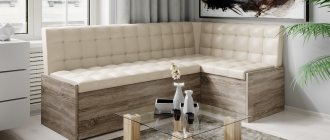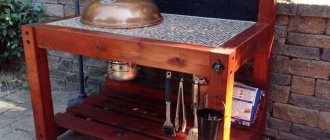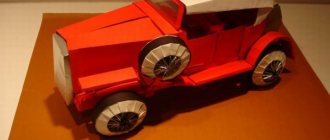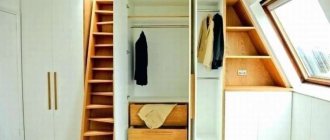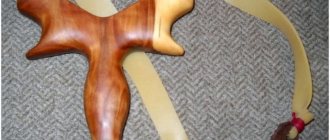The idea of building a bench from leftover materials for a bathhouse or house looks quite attractive, both materially and financially. In fact, a DIY log bench is a great way to make furniture for a suburban area that will last for several decades.
Exclusive model, hand-chopped
Wooden bench for country garden
Modern summer residents are very different from the people who worked in their gardens before. Today, many people use the dacha as a place for relaxation, and not for occupational therapy or obtaining food for food. People come to the countryside to get some fresh air, take a break from the bustle of the city, invite friends to a holiday, or just sit on a country bench and cook barbecue.
Many people arrange their plots as a summer garden, a large park with a pond and aquatic vegetation, or as a small arboretum with a variety of exotic plants.
And in order to have a good and comfortable rest among this fragrant beauty, you always need a place to sit down and think about the urgent and painful. And for this purpose, the resting place is equipped with benches, benches and other structures.
This article discusses the issues of making benches for a country garden.
Making a bench or bench yourself from wood only seems difficult at first glance. On the Internet you can find a large number of different schemes for independent work on making some kind of elaborate bench, one of a kind and inimitable. This design looks original and impressive, and it is not difficult to make in practice.
First, you need to find the initial details from which you will create a small miracle of architectural and design thought. Often an old house in the village is purchased for a summer cottage. And you shouldn’t throw everything in a landfill; often it’s old things (or just fallen trees and unusual branches) that can be useful in such work.
Bench with cart wheels
Wooden bench with a cart wheel
In the village there will always be unnecessary, outdated cart wheels that are used to support a future bench. It turns out to be an ordinary bench from any available material, but wheels are installed as handrails for it. The seat looks very interesting and elegant, and will remind you of past times, of horses and peasants on carts.
An ordinary log as a base
Such structures are often found in villages, but nevertheless, the bench looks impressive. Thanks to its natural shape, it fits harmoniously into the design of any landscape. Wood with a large number of knots, irregularities and twisted elements looks especially original.
Log at the base of the bench
The log is installed on horizontal logs, which are screwed with long screws from below. Then, wood is removed from the top of the tree trunk at an angle to create a seat and backrest. Then the log is cleaned, and the seating area itself is polished. The final look of the bench will be given by colorless varnish, which will emphasize the structure and naturalness of the wood.
Bench made from cross cuts
Bench made from cross-cut wood
When preparing firewood for the winter or for the barbecue, short trimmings remain. Such cuts are also prepared specially by sawing the logs into short washers of the same thickness. The blanks are split into small pieces and then the bench is decorated. The base itself is made from available material. The pieces of wood are placed very tightly together, and the remaining space between them is filled with glue, sealant or epoxy resin. The finished product is sanded and varnished.
Bamboo bench
Thin bamboo branches are used for the inlaid seat and backrest. But for this option, a special iron frame is made. Instead of thin bamboo, hazel twigs are sometimes used. The bench turns out to be simple, elegant and unusual.
DIY log table
For example, in this video you will see in two minutes how a master will make a simple set of a bench and a table in a “wild” style without a single nail:
By the way, to strengthen the structure, no one bothers to use glue, nails, etc.
The tabletop can also be installed on a wide stump, which remains from a cut down tree. In general, if there are stumps left on your site, take a closer look at them before uprooting them. Perhaps, if they are positioned well, it will be possible to install a bench on them, but certainly - you can put a table! In this case, it is better to knock down the tabletop from rough boards, or use a homogeneous array.
If you make a table entirely from logs, then the principle is the same as in the construction of benches. The structure is assembled in the same way as a log house - the elements are placed in grooves. If it is necessary to increase rigidity, fasteners and glue are used.
The following image shows a one-piece structure that combines both a table and benches. Doing this is technically no more difficult than a separate bench. The only difference is that you need to tinker with calculations and drawings; you can’t do it by eye.
Single chopped design of a table and two benches made of thick logs and half-logs
Option 3: from a single piece of wood
Another interesting option for making a simple bench with your own hands without a single nail is to cut it out of a medium-width log. The presence of thick branches will not complicate the task, but will simplify it. They can be used as legs. If there are no branches or they are weak, you can make a base as in the previously discussed type of bench. The log is sawed lengthwise with a chainsaw, then the branches are cut down or trimmed. You need to ensure that the bench is stable. After all, the wood is sanded, treated with varnish and antiseptic.
Very often, coniferous trees are used to make benches. Therefore, care should be taken to get rid of the resin, otherwise unpleasant incidents will arise during operation.
Basically, two methods are used for this purpose:
- Acetone is mixed with water in a ratio of 4:1. The resulting solution is applied to the log with a brush until completely absorbed. The remaining traces are washed off, the wood is dried with a hair dryer.
- Acetone is mixed with caustic soda in a ratio of 20:4 (it is acceptable to use soda ash and potash, but then their proportion will be 6:5). With a solution diluted to the consistency of sour cream, coat all tarry areas in several approaches.
A simple way to make a “wild” stool from thick wood
... which you won’t be ashamed to put in your home. Look how easy it is:
Please note that it is not at all necessary to master a chainsaw, since the scale of the workspace allows you to correct the unevenness of the first cut.
Such a stool will fit into the interior, as well as a table made of logs, especially in a log house in the “wild style”.
Another method of making a stool, where you don’t even need to cut anything out:
A thick enough piece of wood can make an excellent chair. If you burn it, sand it and varnish it, you get an exclusive product that would be a pity to take outside:
Manufacturing technology
Almost anyone with carpentry skills can build a table from logs. Before work, you should select suitable logs and prepare tools. It is also necessary to determine what shape and size the table will be.
Tools and materials
To work with wooden material, the following tools are required:
Article on the topic: DIY Provence style chandelier
- plane;
- hammer;
- saw;
- chisel;
- axe.
To make a table from logs, do not forget the chisel
- hacksaw;
- drill with screwdriver function;
- file;
- paint brush.
The material you need to select is:
- nails;
- self-tapping screws;
- iron rods with a diameter of 15 mm;
- wood varnish;
- sandpaper with different spray fractions;
- glue for metal and wood;
- logs;
- smooth hewn boards more than 2 cm thick.
Don't forget about sandpaper.
If necessary, you can use stain to open up the wood.
Drawing
Before work, you need to determine the layout of the logs and the dimensions of the table. To make the product correctly, you should use a drawing with the exact parameters of the entire structure.
When aligning logs on one side, three-dimensional sketches are performed. Without turning the logs, you can use a two-dimensional diagram of all the constituent elements.
All parts in the drawing must match each other. You can separately sketch the length, width and height of the log table.
Preparation of logs
The material is selected according to the drawing, which indicates all the required dimensions of the product. You can build a table using logs without surface treatment. This table will look rougher.
To build a product from hewn wood material, you will need to spend a little time preparing it. To do this, use an ax or chisel with a hammer to remove all the bark from the tree. In this case, it is necessary to make the surface of the log as smooth and even as possible.
To make a table from logs you will need to remove all the bark
If a table is supposed to be made of log halves, then you may need to cut along each material. You can do this procedure yourself using a chainsaw or entrust it to professionals at a sawmill.
Special grooves can be made to connect wood material. But this requires additional tools and skills. There is a simpler way - this is to grind a small area at the joints with a plane. The width of the flat surface should be more than 3 cm.
Article on the topic: DIY round table
To create a beautiful shape, the edges of the lower and upper logs can be cut at the same angle - 45 degrees. All roughness and protrusions are processed with a file to a flat and smooth surface.
After this, holes should be made to install the iron rods. The drill must match the diameter of the selected reinforcement. Holes should only be made at right angles. Their location should be the same in each log. All edges of the wood material are carefully sanded. The surface must be completely smooth.
Assembling a log table
After complete preparation, the logs are assembled into a single structure. Initially, the base is installed. An iron rod is installed in the hole made in the lower log. Next, according to the diagram, all drilled elements of the table are fixed to the reinforcement.
After assembly, the protruding rods are cut off. If the design is correct, then you can start gluing it with special wood glue. To do this, you should disassemble and reassemble the structure, coating all joints with adhesive solution. Then reinforcing rods are inserted into the holes of the fastened logs. Additional glue is poured into the last remaining visible opening. This strengthening of the material will give the product additional strength and will avoid loosening of parts during prolonged use.
Tabletop mounting methods
The table top can be installed in two ways.
First
After assembling the lower structure, you can begin making the tabletop. Most often, logs sawn lengthwise are used as material for covering a log table. This option is quite practical and reliable.
To make such a tabletop, it is necessary to make an even longitudinal cut of the prepared and measured material. After this, it is imperative to perfectly level the sawn surface, and then clean it to a smooth state. The process uses a plane and sandpaper coated in various sizes.
Log table with a perfectly flat top
Article on the topic: How to make a table from boards with your own hands
All edges are also processed. Using a file, all sharp protrusions are cut off. The table cover can be secured with self-tapping screws.
Second
The table covering material can be chipboard. The chipboard sheet is cut according to the required dimensions. It is secured using self-tapping screws. For tables larger than one meter, additional supports should be installed, since chipboard can deform even under light loads. To do this, a special timber ceiling is installed, onto which the material is fixed. To avoid chipboard swelling from moisture, you can cover the sheets with a special self-adhesive protective film.
Final finishing of the structure
After completely assembling the table from logs, you can begin to varnish it. Apply varnish only to a clean surface. The coating is carried out in two layers. After each finishing, the protective agent should be allowed to dry completely.
A simple “wild” bench without a single nail
How to make a bench is already clear. To get a bench, you only need to attach the backrest. It can be attached without a single nail, screw, etc.
To do this, take two bars of triangular or trapezoidal cross-section. We get it from one, sawing it in the middle. A triangular section is needed to make a dovetail connection between the bars and the seat and backrest.
Dovetail connection: trapezoidal tenon into trapezoidal groove.
In the half-logs for the seat and back, triangular (trapezoidal) grooves for supports are cut out so that the wide part is inside the half-logs. Then all the elements are connected in these grooves. In the video you will see that it is easier than it sounds in words:
But this is more difficult than it looks. The main difficulty is to cut grooves of the desired shape at the desired angle in the rounded surface of the half-logs. Without certain dexterity and experience in working with a chainsaw, this is not easy.
There is a simpler option - do without the dovetail, use self-tapping screws or nails to attach the backrest supports to the bench. The supports are attached to chocks, which serve as legs; they can also be attached additionally to the seat mass. The back can be secured in the same way by cutting out moon grooves in the supports themselves, if they are thick enough. We get approximately the following:
Simple and stylish - a bench made of logs.
To make the benches and benches described above, you need initial logs from approximately 35 cm in diameter (if we take the same ones). This is dictated by the comfortable parameters of the bench or bench itself. Its height is 40-50 cm. The height of the seat plane is about 1.5 times the diameter of the log. The final calculation depends on the depth of the groove, but it is not necessary to cut it deep.
Another important note:
For two benches, it is advisable to cut the log in half, but for a bench, it is better to move the cutting plane away from the diameter plane, so that the beam for the back is smaller than for the seat. Firstly, your bench will be 5-10 cm higher, which is important if the log is not thick enough. Secondly, do not forget about the center of gravity of the bench.
If the half-log for the back is as massive as the seat, and the back is sloped, then the structure may be unstable. This problem can be solved if you rigidly attach the seat to the lower supports, but you will also be sitting on this bench! And you'll want to sit back!
To prevent the center of gravity from shifting so that the bench will tip over or wobble, the top of the backrest should not extend beyond the vertical axis passing through the extreme points of the lower supports and legs. It is better if the legs protrude further than the back of the bench.
The relative position of the extreme points of the rear legs and the back of the bench
Another significant parameter. There are various original design benches, chairs, etc., but for a standard bench or chair, the backrest slope is within 30° from the vertical axis.
Tips for choosing material for a bench
Traditionally it is a wooden log that is processed. It is necessary to choose a wide log so that when cut you get a seat and back of a comfortable area. Some people use pre-prepared planed boards along with logs. Ordinary logs do not need specific processing, unless they are coniferous logs. The main problem here is the remaining resin. Wood requires that it be deresined, since during use it can stain the clothes of those who sit on it.
Bench with backrest with tongue-and-groove joints
The next project is an outdoor wooden bench with a backrest. It has a fairly strict appearance and will become a functional decoration in any garden or dacha. The vertical slats of the back give the massive structure visual lightness. Shaped armrests and a curved top bar add Japanese influences to a clean, classic look. It is simply created for carefree contemplation on shady alleys, and will look even more expressive surrounded by greenery and flowers.
If in the previous two projects we talked about how to make benches using simple carpentry joints, then here we will talk about the classic tenon-socket connection. It underlies all design elements of the project. You will have to make a lot of spikes and nests, so it is advisable to think about optimizing this process in advance. The simplest and most affordable option is to use a hand router and a saw table.
Advice! For accurate and quick selection of slots, use a homemade milling template with slots of the required sizes.
Drawing of a bench with a wooden back
Advice! Decorative antique finish perfectly complements the simple design of this wooden bench with a backrest. Use the brushing capabilities to texture individual structural elements - the top crossbar, the middle backrest and armrests. The combination of smooth and aged surfaces will create an original design contrast.
Prepare the details
According to the dimensions specified in the drawing, make the main parts of the bench. To quickly apply markings, use pre-prepared templates. Duplicate parts can be mass produced. After cutting, fasten all the identical parts into a pack and process their ends with a sander, this will significantly speed up the work process.
Make spikes
On the saw table, form tenons on all tenon pieces, following the dimensions from the diagram. Using a groove disc will make this job much easier. This can be done no less carefully with a regular saw blade, followed by trimming the waste with a chisel, as shown in the photo.
Mill out the sockets
Assemble the sidewall
Perform dry assembly of the sidewall. If the joints in the structure are not tight enough, fine-tune them using one of the methods we discussed in the article “Perfectly Fit Joinery Joints.”
Carry out sequential gluing of the structure
After checking the accuracy of the fit of the connections of the entire bench, proceed to sequential gluing of the base elements first, and then the back. After the glue has completely dried, attach the seat strips with self-tapping screws.
Bench assembly
The bench should be assembled at the place where it will stand. To make a bench from logs, you need to do it from the side in this order:
- Mount the stop with the flat areas facing down. The distance between supports should be 1.7 meters.
- After that, the armrests are mounted so that the distance to the center of the armrest is approximately 20 cm. To secure them, it is best to use dowels.
- The seats are mounted in recesses in the supports, and dowels are also used for fastening.
- The backrest is mounted into the grooves of the armrests and secured with self-tapping screws.
- Primer treatment and painting or varnishing.
This method will allow you to independently create a bench with a back to decorate your garden plot. Additionally, you can decorate the bench with carvings, burning patterns and massive forged elements.
Types of log tables
Tables made from logs are quite relevant for country houses. They are simply installed in the yard under a canopy or placed in the house. This piece of furniture looks especially beautiful against the backdrop of timber buildings.
Log tables differ in the shape of the tabletop:
- Rectangular, long design. It is convenient to gather at such a table not only for the whole family, but also to invite guests.
- With rounded edges. The semicircular shape gives the table an elegant look.
- Square. This tabletop looks good in small gazebos.
Rectangular table made of logs
The dimensions of log tables depend on the place of their use and the number of users. A special feature of such pieces of furniture is the unusual design of the legs. They can be made either from a round log or from its halves.
The tables are made from rounded logs of various types of wood. Often such material remains after the construction of houses or various garden buildings. You can make a log table with your own hands from leftover wood.
Materials and tools
Prepare everything you need for work:
- Logs with a diameter of 30 cm. The harder the type of wood, the longer the table will last you. And if it is an oak round timber, the result of your skill will be inherited by your children and then your grandchildren.
- Stain or other wood impregnation agent. This treatment will protect the material from rotting and parasites, and will make it more resistant to aggressive external factors.
- Axe.
- Bit.
- Hammer.
- Chainsaw.
- Electric drill with thick drill bits.
- Nails, large screws.
- Sandpaper.
- Universal glue (preferably epoxy).
- Grinding machine with attachments of different grain sizes.
- Stain to improve the protective qualities of wood.
- A varnish that is suitable for treating wood.
The last stage of making the table
If you have a tool such as a drill, and you have a special attachment for grinding, then you should definitely use it. But in case of its absence, you will have to achieve a smooth table using sandpaper.
Article on the topic: DIY rocking chair made of wood
After you achieve the desired result, all you have to do is coat your product with varnish. First you need to clean the table from debris and dust, and then degrease it. You can use absolutely any varnish intended for a material such as wood. You can use a brush for application or a roller, but it will be most convenient to use a spray can, which will ensure even coverage of the product. After you have covered the table with several layers of varnish, you need to let it dry.
A table made of logs with your own hands is ready. All you have to do is enjoy your work and get pleasure from using it.
Using wood in a summer cottage
Currently, hardware stores offer a choice of a huge number of different ready-made sculptures and other elements for the garden, made from various materials.
But it’s better not to be lazy and make country crafts with your own hands - making them from wood, unlike stone or metal, is not so difficult, and the resulting result will exceed your wildest expectations.
Craft ideas
Let's focus on interesting and easy-to-implement designs:
- The most common option is wood sculptures. This can be a figure made from a single log or made up of several parts connected to each other in one way or another.
- Crafts made from branches and stumps that resemble animals, birds or fairy-tale characters look good. In this case, you practically do not need to make changes to their natural shape; just clean the material from the bark and varnish it.
- Plywood is good for creativity. Draw a stork, a windmill or a frog princess on a sheet of paper, cut off the excess parts and paint the product.
- You can also make excellent containers for plants and birdhouses from plywood. Another beautiful and useful thing is a feeder.
Logs as a material for creativity
Very often, when designing a summer cottage, it is necessary to cut down one or more trees. Of course, they are perfect as firewood, but it’s better to show your imagination and use them for crafts made from logs for your dacha: you can easily make a flowerbed, bench or decorative well with your own hands.
Let's look at these options in more detail.
- Flower bed. For most summer residents, it is not a novelty made from various available materials: plaster, empty glass bottles, old car tires, and so on. But it is the old log that is suitable for this purpose like nothing else.
For manufacturing you need a hammer with a chisel or a chainsaw. By making a recess of the appropriate size and placing the log on supports, you can learn an unusual and attractive product absolutely free of charge. All that remains is to fill the hole with soil and plant flowers.
- Garden furniture. An excellent solution, but not so easy to implement. First of all, you need to select a log of sufficiently large diameter. Then carefully process it with various tools:
- the first stage is an ax or chainsaw;
- second stage – chisel and hammer;
- the third stage is grinding and applying a protective coating.
- Decorative well. A very beautiful accessory for a summer cottage. The downside is that old wood is not suitable for manufacturing. You need to purchase high-quality round timber and build a log house from it.
Wall panels
Eco-decor can be taken as the basis for a design project; it will look great. Let us note that the level of stylistic design depends only on talent, imagination and perseverance, since any products made from dry branches require careful implementation. Almost anything can be made from driftwood, scraps of wood, various large dry branches, thin tree trunks - furniture, lamps, decor and, of course, wall panels.
Branches in a picture frame
The theme of the autumn forest was repeatedly revealed by many artists, for example, Klimt. Trees with fallen leaves create a calming atmosphere that promotes relaxation. Meanwhile, such decor for a hallway, living room or bedroom made of dry branches reminiscent of a forest can be decorated with bright elements at any convenient moment; they will thematically enliven the interior and bring natural beauty into it.
Panel of twigs on a wooden base
To make panels from branches for your home, you will need flexible specimens that can be given any shape, and can also be easily placed along the wall. Fastening dry branches to the wall is ensured with the help of staples, self-tapping screws, followed by grouting the cap, and “liquid glass” glue.
Wall decor with tree branches and cuts
For small dry branches use a glue gun. This method will be invisible and look organic from the outside. Branches for decoration go well with modern furniture, complement the Provence style, shabby chic - they will always look good.
Flowerpots for the garden made of tires
Before you get creative, you should have at hand:
- car tire;
- glass of water;
- sharp shoe knife.
If you know how to use an electric jigsaw, then trust this tool to do the job. If you are cutting with a shoe knife, then dip the blade into a glass of water more often to make this difficult process easier.
To ensure that the flowerpot has a beautiful leg, attach the first cut zigzag piece to the bottom of the inverted tire with self-tapping screws. Make holes in it for water drainage.
All you have to do is paint your creation, pour soil into the flowerpot and plant flowers. This is how they create crafts from tires. But you can make not only flowerpots out of them. A swan made from a tire will also turn out beautiful - it’s a kind of mini-flower bed. Flowers will also grow in the bird.
Model selection
The choice of the master is determined by the availability of available material, the purpose of the bench and the level of working skills.
For the most inept and unpretentious, an option with a large-section log or beam laid directly on the ground is suitable. The only thing that needs to be done is to level the surface and treat it with a protective compound.
Beginners should try their hand at extremely simple models made of calibrated timber and boards without a back or decorative elements.
Those who have a chainsaw and at the same time have the opportunity to get a large-diameter barrel can be advised to “just remove all that is unnecessary”, obtaining a product of the required shape.
For those for whom the ability to work with wood, a good set of tools and materials removes all restrictions, you can choose any model - from purely wooden to combined, for example, with cast or forged elements.
Preparation
- First of all, you need to prepare a drawing, which will indicate the parameters of the component parts. If you are going to align the logs used on one side, then you need to make a three-dimensional diagram. You can choose the size of the table, as well as the shape of the tabletop, but maintain the proportions to make the table strong and stable. Your diagrams and drawings may be formatted like the ones below.
- Prepare the logs. Check the amount of work material with your plans. If there are not enough logs, you will have to:
- limit yourself to a simpler option - make a table on log legs;
- do not abandon the idea, but purchase additional material.
- Remove the bark from the logs using a hammer and chisel.
- Process the cleaned material with a plane. On the lower parts of the trunks, remove a small layer of wood, making the contact surface smooth. This way the logs can be stacked one on top of the other. The cutting width should be at least 4-5 cm. Using another method of laying - “in a bowl” - requires more labor. A semicircular depression is cut into each upper log. Then the top log is laid on top of the bottom one. In both the first and second cases, additional fixation with screws, dowels or fittings will be required.
Article on the topic: DIY furniture for outdoor recreation
- Give the base parts a neat shape at the ends. To do this, cut the edges of the lower and upper logs at 45 degrees. Continue this bend along the trunks towards the center, making the intermediate elements shorter. The shortest one will be the central log.
- Be sure to sand the sharp edges to make the elements of the future table safe.
- Proceed to preparing the holes for the reinforcement. In the log that will be located below, it is enough to drill only half the thickness. In each log located inside, you need to make several through holes at a distance of 30-40 cm. In joining logs, the holes should match, and the drilling angle should be 90 degrees. You need to do the work with a drill whose diameter is the same as that of the reinforcement you are using.
- Using a plane we correct uneven areas and rough areas. Carefully sand the surface of the parts with sandpaper. Start with a coarse-grained abrasive paper, such as a four-grain sandpaper, and then use a finer one.
How to build benches yourself?
In order to build a comfortable bench with your own hands, you need to make a sketch of it. There are optimal sizes of garden furniture that must be observed:
- seat height above the floor - 40 - 50 cm;
- width (depth) of the bench - 50 - 55 cm;
- the height of the backrest above the bench is 35 - 50 cm.
These dimensions allow a person of average height to sit comfortably, lean on the back, and stand up easily. If the owner’s build differs greatly from the average, then the dimensions of the bench will have to be selected individually. The backrest is usually made with a slight tilt back. For more information about wooden benches, watch this video:
To work with wood you will need the following tools:
- hacksaw or jigsaw;
- drill and screws, or hammer and nails;
- roulette;
- pencil.
To assemble products of complex shapes, wood glue can be useful. It is used to fasten parts that are connected using the tongue-and-groove method or with a furniture dowel. For plywood products, long metal threaded studs and nuts are useful.
Driftwood and branches in the garden
Any wood is a material for creativity. A board with a greeting is laid out from thin branches.
The decor on the welcome board is attached with glue
Thick ones are used to make unique garden furniture.
A stylish chair will last longer if you remove the bark from the branches
Interestingly shaped driftwood will give your garden a picturesque look if you simply place it among the plants.
Don't pass by beautiful driftwood - it's very rare
And with the help of glue and screws, various animal figures are made from pieces of wood. But first, the bark is removed from the branches and they are lightened.
Step-by-step instruction:
- Soak the material in a solution of soda ash: 2 cups per 7 liters of hot water. Place a weight on top.
- After 3 days, remove the bark using a wire brush.
- Then immerse the branches in a bleach solution for 2 days: 1 glass per 7 liters of water.
- Dry in the sun for 3 days.
- Sand with fine-grit sandpaper.
Selecting material for drawing up figures is a long but exciting task.
Useful tips
To make garden benches, you should use high-quality material. The service life of the product will be extended by treating wooden and metal elements with special primers, paint and varnish.
The surfaces of the parts should not have irregularities, burrs, or protruding sharp parts of fasteners.
To install the bench, you need a flat area without stumps, holes and stones.
It is recommended to make the back and seat from separate parts, leaving gaps between them for ventilation.
The bench should not be placed under fruit trees. Falling fruit will quickly ruin its appearance.
Bench made of chairs
Often, old but durable furniture is used to make a garden bench. A comfortable bench for a country veranda or gazebo can be quickly made from a couple of old chairs.
In addition to chairs, you will need:
- board 30-40 mm thick;
- bars with a cross section of 40 X 40 mm;
- self-tapping screws;
- drill;
- saw;
- varnish or paint.
Operating procedure.
- Remove the upholstery from the chairs, inspect the product, and sand the surfaces.
- Remove the seat frames and adjust the height of the legs if necessary.
- Make a frame from the timber and attach the boards to it.
- Install a bench. If desired, the seat can be made soft by laying a layer of foam rubber and covering it with material.
- Paint the product.
Instead of boards, plywood is often used. You can complement the bench with decorative pillows.
Option 1: from birch logs, without peeling the bark
For this design, birch logs with an attractive bark texture are best suited. However, when assembling a bench with your own hands, you can proceed from the material that is available. Select more or less even logs with a diameter of 15-20 cm.
Calculate the width of the bench to be made yourself, take into account the installation location and the number of those who will sit on it at the same time. You should start working by cutting the logs into 15-20 identical sections. There is no need to draw drawings on paper, but drawing the outline of the future shop on the workshop floor will be the next step. The bench is made like a chaise lounge: taking into account your height and build, select the required bend.
The logs are placed “on the butt” along the contour line and connected. To fasten them together, holes are drilled into which self-tapping screws are then inserted. To strengthen the structure, you can attach a metal plate to the bottom of the bench (with the same screws) that follows the bend.
The last step in making this simple bench with your own hands is to install one log under the back support. Thanks to him, the bench will acquire good stability. When the tools are at hand and you have a little carpentry experience, it will take a little over 2 hours to create such a bench for your garden. Additionally, you can soak the logs from which the bench is assembled with a wood preservative. This approach will prevent the infestation of bark beetles, mold fungi and other parasites; as a result, the bench at the dacha will last for several seasons.
Protecting the bench from external influences and decorating
Like benches made from pallets, it is advisable to paint benches made from logs with varnish upon completion of production. This way you will protect it from bugs, moisture and other adverse environmental influences and extend its service life. It is advisable to renew the varnish layer every new season, that is, at the beginning of spring.
Decorating benches made of logs, in fact, is not required, but their authentic appearance can be complemented by clay jugs and bowls on the table or back, carvings, a blanket made from pieces of fabric and climbing plants planted nearby.
And finally, a small idea: a bench made of logs is an original Russian piece of furniture. It can be used not only in the garden, but also in the bathhouse, kitchen or on the veranda.
Drawings with dimensions of log benches
Building a bench with your own hands will not be difficult, even for a novice carpenter. The obvious advantage of such benches is the large thickness of the workpieces, be it half-logs, remnants of cuts or cuts, or trimmings of rounded logs. Even if a mistake was made with marking and cutting, you can always correct the defect. Most often, the design of the bench will not suffer from this.
Before you take on the first drawing you come across, you should pay attention to the features of constructing the supporting part of the bench.
The bench support can be made in several options:
- In the form of two massive supports cut from large diameter logs;
- The bench can rest on two short horizontal pieces of log; most often, such a bench is equipped with a narrow seat and a high back;
- At the base of the bench, two elongated logs or half-log sections can be installed, with most of the length of the supports moved “behind the back” of the bench.
In the first case, the bench, due to the lack of a backrest and the large surface area of the supports, turns out to be quite stable when installed on soft ground.
Bench stability condition
The second case is considered the most difficult, since due to the horizontal arrangement of the log sections, the height of the supports is small, and it is necessary to increase the number of “short ones”.
But still, after installing a rather massive and high back, the log bench turns out to be very unstable. Therefore, such benches are usually installed on an area paved with tiles or covered with crushed stone.
Have to use hard surface
A log bench will not tip over spontaneously only if the extreme point of the backrest is on the same vertical line with the extreme point of the lower support.
The problem can be solved only by increasing the length of the support, for example, installing additional sections of logs according to the diagram given below.
We either make the supports long and undercut, or move them far “behind the back”
You can simply lean the bench against the wall of the building, sometimes this is the simplest and most effective way to prevent it from tipping over.
You can just lean the back against the wall
If you make the most reliable bench from scraps of logs, then the optimal solution would be the design shown in the drawing below.
A pair of rear posts supporting the backrest are buried in the ground to a depth of at least 20 cm; on the one hand, this complicates the design of the bench, but on the other hand, the bench turns out to be incredibly reliable and stable.
The solution of installing a bench on elongated log supports can also be considered successful.
It is clear that to increase the comfort of the seated person, the height of the seat of the bench must be raised to a level of 45-50 cm above the level of the platform. You can use massive log decks or assemble racks from several rows of material of smaller diameter. In the latter case, it will be necessary to additionally install a horizontal crossbar under the seat, otherwise the bench will swing in the longitudinal direction.
Labor and cost
Preparing wood, sawing logs, making grooves and other operations is a rather complex process that requires maximum care and experience from the performer. For professionals, it will take at least 2 hours to complete all operations, for inexperienced users – much more.
The cost of furniture will depend on the type of wood (if the material needs to be purchased) and the price of consumables. For example, one self-tapping screw costs at least 5 rubles, plus additional funds for protective compounds: the price of 200 milliliters of varnish is about 200 rubles, a can of protective impregnation will cost at least 600 rubles.
